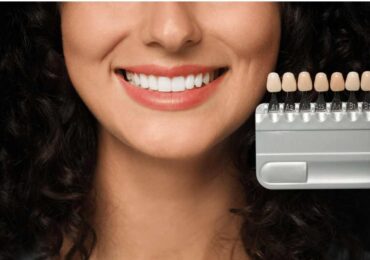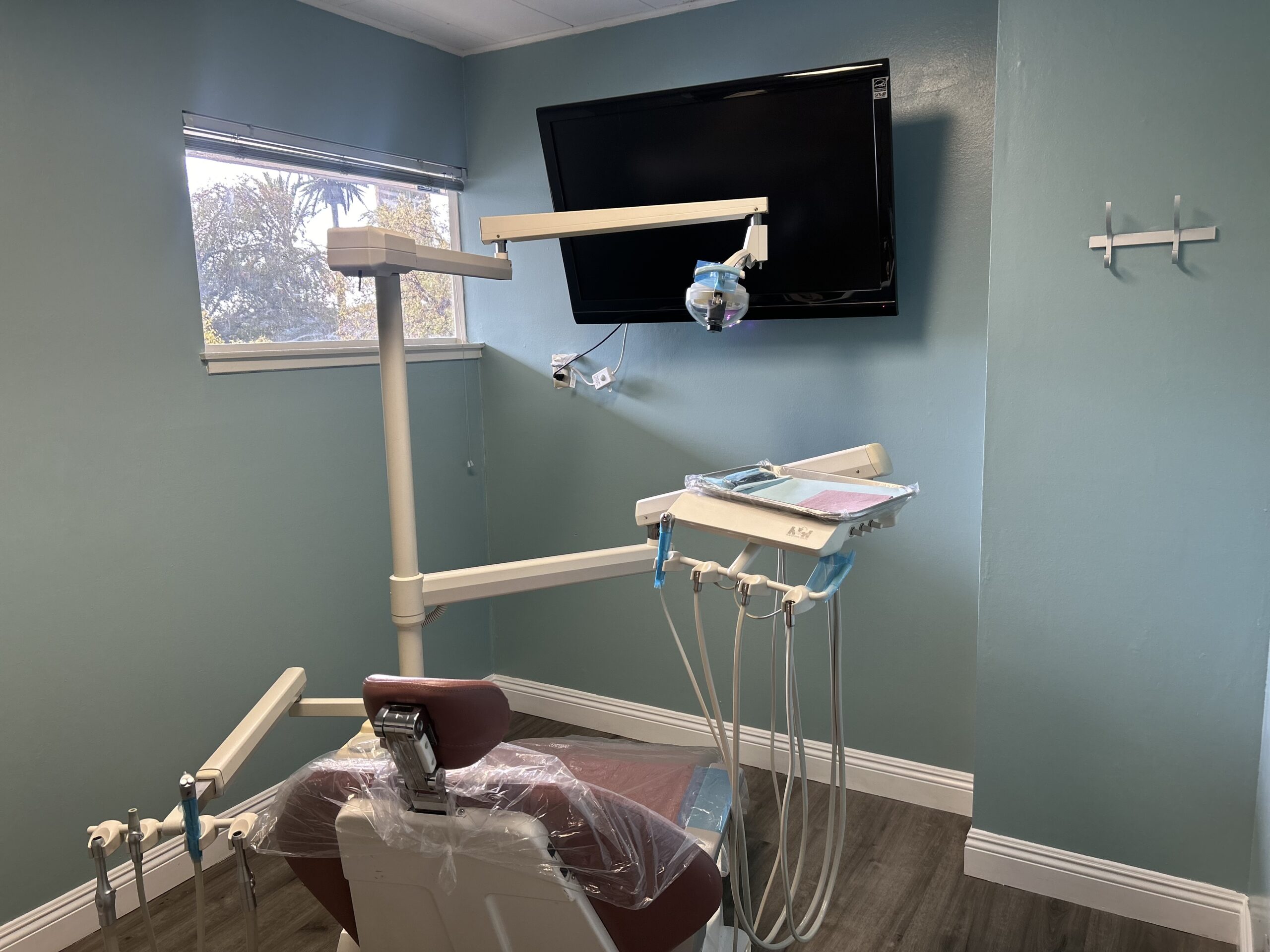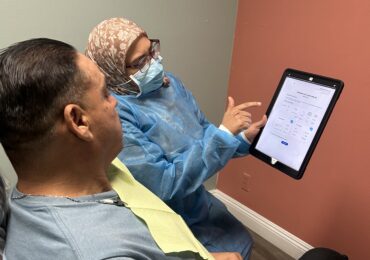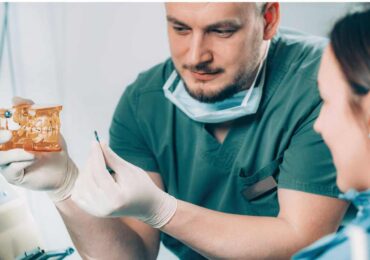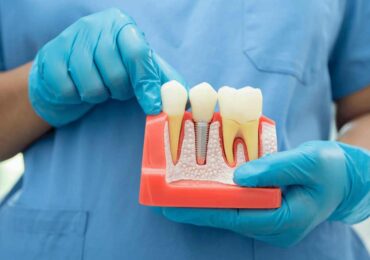In cases of completely edentulous patients (patients missing all their teeth), a traditional implant-supported prosthesis treatment is almost impossible. Recommending regular implants might be tricky due to jawbone issues. All-on-four dental implants can address this problem.
What exactly are these implants, and how do they work? You’ll find out in this article.
What are all-on-four dental implants?
In the late 1990s, implant dentistry was a growing field, but replacing an entire set of teeth primarily relied on individual implants and dentures. While both offered some solutions, they could be costly and time-consuming. The introduction of all-on-four dental implants marked a significant advancement.
Although dentists had long used implants to support dentures, the use of a 45-degree angle for the implants in the back of the mouth was a significant advancement. Only four of the implants could support a full set of teeth due to their angled design, which increased their stability.
All of a sudden, there was a more dependable, affordable, and timely way to replace lost teeth. The procedure is known for being more efficient than traditional implant methods. While some discomfort and healing time are expected, it may be less compared to procedures requiring multiple individual implants.
How do all-on-four dental implants work?
All-on-4 procedures typically take a few hours to complete, depending on your specific case and needs. It may take some time for your dentist to put the implants and affix the replacement teeth, but this is typically completed in a single visit. While some patients may need to schedule follow-up sessions or extra appointments for fine-tuning, most patients find that their treatment is finished in just one visit.
Here’s a quick look at a step-by-step procedure:
Consultation
The dentist wants to know about your oral health and what you want. The dentist will examine your teeth, take X-rays, and discuss whether or not All-on-4 is right for you.
Treatment Planning
Your dentist will create a personalized treatment plan as soon as you decide to proceed with the surgery.
Preparation
Your dentist may suggest some preparation work before your procedure. This can include getting any necessary dental treatments done like gum therapy or extractions that can ensure that your mouth is prepared for the implants.
Surgery
For comfort during the procedure, your dentist will administer anesthesia to you, then the dentist will place them in position into your jawbone where they are going to be restored carefully according to a predetermined plan.
Placing Temporary Teeth
After inserting implants, dentists give patients temporary teeth while working on permanent ones. You can also walk out of his office on that day with a brand-new smile.
Healing and Recovery
Get some rest and let your body recover. Follow your dentist’s instructions for self-care, which may include taking painkillers, eating only soft foods, and avoiding strenuous activities.
It will take multiple visits back to the dentist’s office to ensure that everything is proceeding as planned. They also require impressions of your mouth to create the final set of teeth for you.
Final Prosthesis
After the mouth has healed completely, which could take a month, return to your dentist so they can fit you for permanent teeth.
During the procedure make sure that you will be able to speak openly about any concerns or questions that you may have with your dentist. Also, it is important for you to strictly follow their pre-operative guidelines which might entail refraining from taking some drugs or fasting before the operation. Finally, arrange for someone who can drive you back home after the surgery since anesthesia might make you drowsy.
What to Expect After the Procedure
You may experience swelling, bruising, and discomfort for a few days following All-on-4 surgery. Painkillers and a soft diet might be recommended. You might also experience some bleeding and speech abnormalities. For optimal healing, adhere to your dentist’s recommendations.
With adequate maintenance and regular oral hygiene practices, the prosthesis connected to All-on-four implants can typically endure for a span of 10 to 15 years. A study revealed that the success rate of this treatment is very high, with over 99.8% of patients still having their implants after 24 months.
All-on-four vs. Other Dental Implant Types
Now that you understand the all-on-four procedure, let’s explore how it compares to other implant options. While all-on-four offers a streamlined approach, traditional implants might be a better fit for certain situations. Let’s delve into the key differences, pros, and cons.
Endosteal
Endosteal implants, sometimes called root-form implants, are prosthetic teeth or bridges that are supported by artificial dental roots and are placed into the jawbone. Made from titanium, they act like anchors in your jawbone, providing a strong and natural-looking foundation for your new teeth.
These implants are ideal for replacing single teeth or several teeth, especially if you have enough healthy jawbone. Plus, unlike some bridges, they won’t harm your surrounding healthy teeth.
PROS
- Offers lasting and reliable tooth replacement
- Enhances chewing and biting with a secure base for prosthetic teeth
- Helps maintain jawbone density and facial structure
- Forms a strong, stable connection with the jawbone
CONS
- Involves invasive surgery and prolonged recovery
- Limited to patients with sufficient jawbone density
- More expensive than dentures or bridges
Subperiosteal
Subperiosteal implants are placed beneath the gums but on top of the jawbone, unlike endosteal implants which are inserted into the jaw.
These implants include a personalized metal framework designed to match the jawbone’s contours, along with posts or screws that extend through the gums to support replacement teeth or dental prosthetics.
They’re typically suggested when there’s not enough jawbone for traditional implants, making them suitable for individuals with substantial bone loss from issues like periodontal disease or tooth loss.
PROS
- Ideal for patients lacking sufficient jawbone
- Less invasive compared to drilling into the jawbone, leading to reduced discomfort and quicker recovery
- Offers a stable base for dental restorations like crowns or bridges, as they sit atop the jawbone
CONS
- May not be suitable for those with significant bone loss or gum disease
- Higher risk of infection due to placement beneath the gum tissue
- Pricier than conventional implants due to custom fabrication and specialized placement techniques
Zygomatic Implants
Unlike conventional implants, zygomatic implants are cemented into the cheekbone as opposed to the jawbone. They reach into the maxillary sinus, avoiding the requirement for bone grafting that is frequently required for traditional implants. When patients experience significant bone loss in the upper jaw as a result of trauma, periodontal disease, or extended denture use, these implants are frequently used.
PROS
- Allow patients who have lost a significant amount of maxillary bone to receive dental implants.
- Provide bridges or temporary teeth with immediate support.
- Remove the need for the invasive and time-consuming bone grafting procedure.
CONS
- Involve a more difficult and involved process in terms of technology than standard implants.
- May have possible side effects such as nerve injury or sinus perforation
- More expensive than conventional dental implants
All-on-four dental implants are often preferred over other types for a few key reasons:
- With all-on-four implants, only four implants are needed in your jawbone, simplifying the dental process and speeding up recovery compared to other options.
- Unlike zygomatic implants and other alternatives, all-on-four implants don’t require bone grafting. This means shorter surgical times, less pain, and no extra treatments needed.
- You often get immediate support for a temporary tooth or bridge with all-on-four implants.
- All-on-four implants might be cheaper than more complex options. You could save money in the long run since you need fewer implants and no additional procedures like bone grafting.
Are All-on-Four Dental Implants Right For You?
Missing teeth can impact your confidence and ability to eat comfortably. Thanks to all All-on-four dental implants, you have a revolutionary solution to your smile with a full arch of fixed teeth. But are they the right choice for you?
Here are some questions you might want to ask:
- Do you have any concerns about your current health that might affect implant success? Certain health conditions like diabetes or a weakened immune system can affect implant success.
- Do you have sufficient jawbone density? Bone density naturally decreases with age, so seniors may require additional evaluation to ensure their jawbone can support the implants. If you’re in your teens also, your jaw may still be growing, which could cause issues with the implants.
- Is your lifestyle conducive to long-lasting implant success? Heavy smoking or teeth grinding can put extra stress on implants.
- Have you had a lot of dental work in the past, or is your jawbone not in the best shape? All-on-four implants might require a different approach in these cases.
Life-changing Treatment for Upland Residents
Ready to say goodbye to missing teeth? If you’re in Upland, California, and searching for an efficient and budget-friendly tooth replacement solution, why wait? Come see for yourself why this treatment is revolutionizing tooth replacement.
You’ll be amazed at how simple and affordable the whole process can be. Book your appointment now or swing by our office at Upland Dental Practice, 270 E 7th St Ste 2D, Upland CA 91786.
Got further questions?




